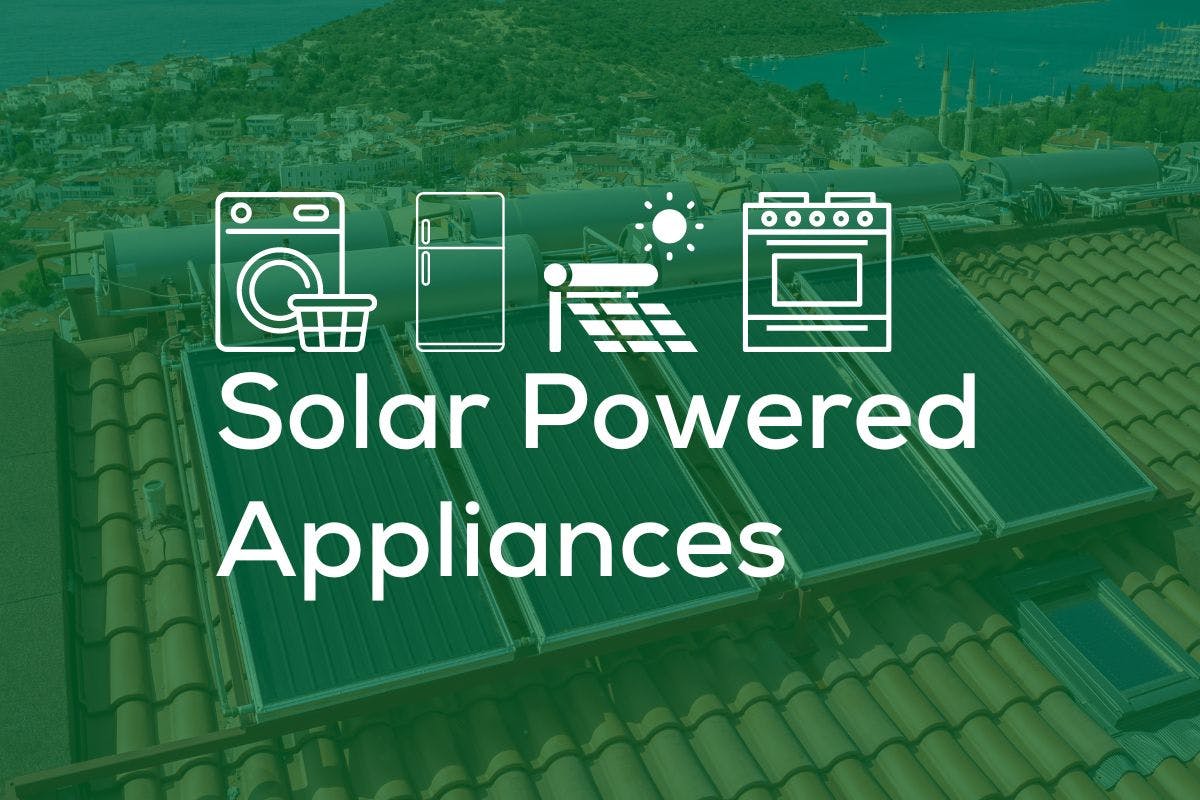Any electric appliance can be a solar appliance. Whether it’s an electric vehicle charger, washer and dryer, solar water heater, or heat pump water heater, if it runs on electricity you can power it with clean, renewable energy from the sun.
You can use solar-powered appliances to save money, reduce your home’s carbon footprint, and be more energy independent.
See how much you can save by going solar with Palmetto
Solar-Powered Appliances
Over the past 20 years, rising electricity prices and increasingly affordable home solar panels, batteries, and inverters have led to a revolution, allowing homeowners to generate their own power and save money.
Powering your home with solar gives you an alternative to grid-supplied electricity. Considering sunlight is free, running a device, or your entire home, with solar can translate into ongoing energy bill savings. Today, home solar appliances can operate in two main ways: as standalone devices or within an integrated home solar system.
Standalone systems and off-grid appliances
Most people who go solar do so with standard appliances, but a few appliances incorporate solar power directly.
- Solar water heaters. Solar water heaters use rooftop collectors (similar to solar panels) to capture the sun's warmth to heat water.
- Solar-powered generators. Solar-powered generators are often portable and can be charged with solar panels.
- Other Solar Products. Homeowners can purchase standalone products such as solar-powered garden lights, solar gate openers, and even a solar-powered refrigerator.
Integrated home solar electric appliances
When you buy or lease grid-connected solar panels on your roof, your home's electric appliances can run on low-cost, renewable energy. Your water heater may not actively collect the sun's heat, but running it on solar electricity is just as clean. Rooftop panels effectively turn any household appliance into a solar one.

Energy use within homes. Credit: EIA.
Integration Challenges and Solutions
Your available sunlight and installation space limit your ability to harness the sun's power and run off-grid appliances with solar panels. Reliant on clear, sunny days to generate power, the same solar panel will produce more annual electricity in Tucson, Arizona, than in Burlington, Vermont. We recommend working with a professional who can accurately estimate your property's solar potential and guide the project to meet local permitting and installation requirements.
Cost-benefit analysis
Solar installations can come with high upfront costs compared to traditional gas-powered generators but can earn money back, unlike generators. They are often a better long-term solution for your home and the environment.
Most grid-tied solar panels have a payback period of 6-12 years if the system is designed to meet your annual electricity demand, depending on your location and energy habits.
The Palmetto Solar LightReach Energy Plan allows homeowners to circumvent the upfront cost and unlock instant monthly savings with solar.
See how much you can save by going solar with Palmetto
Installing enough solar power
Whether running a single device or your entire property with solar, determining the right capacity for your system is essential. Based on your annual energy bills and property features, you can use our solar savings calculator to see what may work best for your home.
To power your home and all its appliances with solar, work with a solar expert to select three key pieces of equipment.
- A solar array. The number of solar panels you need depends on the amount of direct sunlight on your property as well as the total energy demand of your appliances.
- A sufficiently-sized battery. An optional solar battery reduces the amount of grid power you need throughout the night or whenever new solar is unavailable.
- An inverter. Inverters convert electricity from your panels into the alternating current your home devices use.
Managing Solar: Tips for Optimal Energy Savings
Here are a few tips to keep your energy consumption as green as possible by stretching your solar power further.
- Consider installing a solar battery or solar generator to run appliances with stored solar power when grid rates are higher.
- Invest in energy-efficient products and home improvements to consume less power.
- Redeem local and federal tax incentives and rebates for solar and other energy-efficient home upgrades.
- Try using smart plugs to monitor, schedule, and save energy usage on appliances.
- Practice smart usage habits and manage your energy with a solar-tracking app.
Solar-powered appliances make it possible to reduce your energy costs and carbon footprint at home. From solar-powered string lights to full-home renewable energy systems, there are many ways to save on your long-term energy expenses with emission-fee electricity generation and use.
If you’re interested in solar panels for your home, explore Palmetto’s solar savings calculator or speak with a Palmetto solar advisor today. Palmetto’s Energy Advisor can find you savings with other home energy upgrades..
See what solar can do for you:
Frequently Asked Questions
What appliances can run on solar?
Any electric appliance can run on solar power from home solar panels.
Can solar panels run an air conditioner?
Solar-generated electricity can run a central air conditioner or a heat pump heating and cooling system.
What is a solar generator?
A solar generator has solar panels to generate electricity. You can connect appliances or devices to it to use the power portably or in an outage or emergency.
 Andrew GiermakWriter and Editor
Andrew GiermakWriter and EditorAndrew joined Palmetto in Charlotte in August 2024. He’s been a writer in journalism, then in business, going back to almost the 20th century. He’s lived in Indiana, Virginia, Pennsylvania, Virginia again, and now North Carolina for the last 12 years. He likes golf. Is he good at it? Not so much.

